Insane speed, rugged mountains and glaring white snow - not exactly the ideal conditions for any achromat. But hurtling down the slopes at 45 miles per hour is where 14 year old Staci Mannella feels most at home.
Born with achromatopsia, Staci's vision is limited to objects about three feet away, and even those she can't see clearly. Although her color-blindness isn't as pronounced as other achromats, she squints and blinks in the sunlight. But Staci Mannella doesn't let that stop her conquering the world of adaptive alpine skiing. Her next goal? To represent the US at the 2014 Paralympics in Sochi, Russia, as an adaptive alpine skier.
Diagnosis and Childhood
"When Staci was a baby," her mother says. "She had severe nystagmus and looked possessed! Our pediatrician never said anything so we thought she would grow out of it." But at four months, when a child should be tracking objects, Staci didn't.
Worried, her parents took her to a cousin who was a pediatrician. "She told us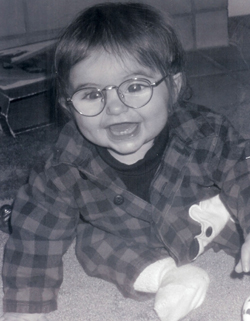 that she thought Staci was blind! We were devastated and brought her to a pediatric ophthalmologist who told us 'your child is severely disabled and her life will never be normal.’” He wanted them to find a blind school for Staci to attend and start the process of learning Braille.
that she thought Staci was blind! We were devastated and brought her to a pediatric ophthalmologist who told us 'your child is severely disabled and her life will never be normal.’” He wanted them to find a blind school for Staci to attend and start the process of learning Braille.
But Staci's parents were not convinced, especially when they discovered their daughter was the first achromat this doctor had diagnosed. They decided to conduct their own research. Through a Med search at their local hospital (the internet not being as accessible in those days) they discovered a series of scientific papers on achromatopsia published by various research centres, including Dr. Reinke and Wills Eye, which was close to their home.
Dr. Reinke has seen more than 200 achromats in his career, so when he told Staci's parents their daughter would live a fairly normal life, they were ecstatic. He helped them implement Staci's early adaptations. When she was four months old, Staci wore eyeglasses with a prescription, which drastically diminished her nystagmus. She wore sunglasses whenever she went outside and did early intervention to help her with tactile and balance issues common in most vision-impaired children.
"We also learned from Dr. Reinke that Staci may not be as color blind as some other achromats. For instance, she didn't know her colors but when she saw something red she would say "Elmo" (as in the red character on Sesame Street)."
With the exception of some of Staci's classmates, most people in her life treated her as they would any other kid. "She looked adorable in her tiny little glasses!" Staci's mom laughs, "I think it embarrassed Staci when we told people she was legally blind, but we felt it was necessary because here is a kid that looks totally normal in every other way, yet she squints and shuts her eyes and sometimes cannot get around by herself. People find Staci inspiring now, amazing and awesome. People really have a lot of respect for her because she doesn't let this get in her way."
Taking to the Slopes
At age 4, Staci's parents took her to the Adaptive Sports Foundation in Windham, NY. As avid skiers, they'd often noticed the adaptive skiers on the slopes at Windham, so naturally, they brought Staci along. They thought skiing could be a great family activity, even with a legally-blind child.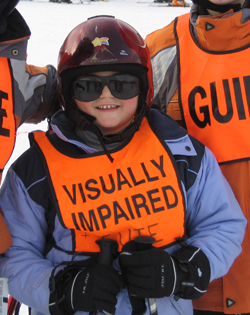 When she first started, Staci would travel down the mountain hanging onto a bambo pole held by two instructors. "We never thought she'd ski independently", laughs her mother. "Boy, were we wrong! By the time she was 6 they took the pole away, and she was able to ski independently by following the guides and listening to verbal cues."
When she first started, Staci would travel down the mountain hanging onto a bambo pole held by two instructors. "We never thought she'd ski independently", laughs her mother. "Boy, were we wrong! By the time she was 6 they took the pole away, and she was able to ski independently by following the guides and listening to verbal cues."
Staci soon became a celebrity at Windham. She wore a vest to identify her as a blind skier. It was a bright orange vest with the words, "Partially Sighted, Totally Cute" printed on it. Soon the adaptive guides at Windham were fighting over each other to be her guide. Several complained of having heart attacks while guiding Staci, because she liked to ski in the half pipe and ski up to the top of the walls until her body was horizontal to the snow. 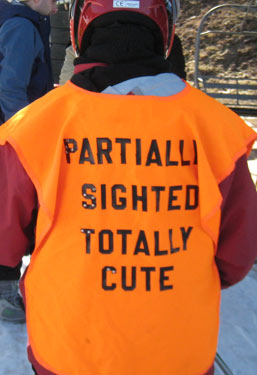 With each year, Staci's skiing would get better and better. When the Adaptive Sports Foundation asked her to join their race team, she couldn't have been more delighted. She was 11.
With each year, Staci's skiing would get better and better. When the Adaptive Sports Foundation asked her to join their race team, she couldn't have been more delighted. She was 11.
At age 12, Disabled Sports USA awarded her a scholarship to attend a development camp and compete in a level 1 race in Breckenridge, Colorado. Only 10 young racers in the whole country were accepted to the camp, so it was a huge honor for Staci. She excelled on the slopes.
In February 2009, Staci was joined on the slopes by Kim Seevers, a nationally recognized adaptive coach and trainer, serves as Staci's coach, guide and mentor. When Staci races, Kim skis 10-15 yards in front of Staci. They use an audio system that allows Kim to communicate to Staci the different elements of the course. Staci wears dark goggles which block out much of the sunlight, allowing her to "see" as much as possible.
"With Kim's help, Staci has improved to a level that we could never have imagined after talking to the first doctor that diagnosed her blindness." says Staci's mother. In March 2009, Staci raced in the junior division of the US Adaptive Alpine National Championships, held in Winter Park, Colorado. Her top speed was clocked at 45 miles an hour and she took home a silver metal in the junior slalom division.
Just a Normal Teenager
How does a 14-year-old girl cope with the pressure of a demanding training schedule alongside schoolwork and a normal teenage social life?
Staci, like many teenagers who live with vision impairment, shows incredible tenacity and drive. The whole family skies every weekend from the end of November to the end of March, and again in the summer at Mt. Hood, Oregon. Staci brings along her school work and completes it between training sessions.
During the rest of the year, she works with a personal trainer once a week, and has a home workout which she follows, too.
Aside from skiing, Staci loves horses, and tries to get to a barn as much as 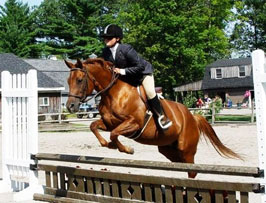 possible to see her favorite animals. "Many children like horseback riding," says Staci's mum, "but not the necessary work that goes along with caring for a living animal. Not Staci. She loves everything about horses, including cleaning out their stables."
possible to see her favorite animals. "Many children like horseback riding," says Staci's mum, "but not the necessary work that goes along with caring for a living animal. Not Staci. She loves everything about horses, including cleaning out their stables."
Like many other children and teenagers with disabilities, Staci's biggest problems have been social. Some of her peers have picked on her because she looks normal, but squints. Staci doesn't care what people think. This experience has only made her more independent and determined.
A Bright Future
Last year Staci competed in the US Adaptive Alpine National Championships in Big Sky, Montana. She was in the visually impaired division, and competed against other visually impaired or blind skiers – many of whom were adults who'd been racing and training for several years and had represented the US at the Paralympic games in Vancouver. At 13, Staci took home a bronze medal in the giant slalom and silver in the slalom.
After she returned from the national championships, Staci set her sights on the ultimate goal. She declared that she would represent the United States at the 2014 Paralympics in Sochi, Russia, as an alpine adaptive skier. She wants to be the #1 visually-impaired female skier in the world.
The Paralympics Winter Games are held every four years following the Olympic Games and allow athletes with physical disabilities to compete against each other in an elite international sporting event. The Paralympics have grown dramatically since the first games in 1960, with thousands of athletes with mobility disabilities, amputations, blindness and cerebral palsy competing in the summer and winter sports.
Many people confuse the Paralympics with the Special Olympics, in which athletes with cognitive disabilities compete. If she continues her current training schedule and keeps up her hard work and discipline, Staci will achieve her dream.
With an eye to her next goal, Staci's last season has seen her toughest training yet. She raced on the able-bodied JIII races, competed in local adaptive races with her Adaptive Sports Foundation teammates, and raced in the national championships. In July, she trained with the US Adaptive Alpine team at Mt. Hood, and can't wait to race in the speed events, downhill and Super G next season. This winter, Staci will be competing in NorAm competition at Copper Mountain, as well as races at Winter Park, CO, Waterville Valley, NH and the national championships in Alyeska, Alaska. The US Adaptive Alpine Team coaches feel there's a good chance Staci will be named to the US team sometime in the near future.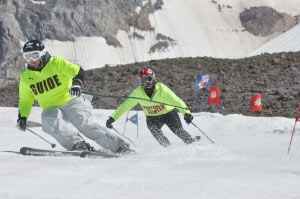
In order for Staci to continue in the sport, attend events and races, and to outfit her and her guide, Kim, in the required FIS legal equipment, her family relies on the support of sponsors and scholarships. For more information about sponsoring Staci, check out her website http://www.stacimannella.com.
Partially Blind - Wicked Fast Skier
At just 14 years old, Staci shows incredible determination and tenacity. Her biggest triumph is never letting her achromatopsia stop her from achieving her dreams. Her stubborn natures means she tries 100 times harder than anyone else, and she never, ever gives up.
